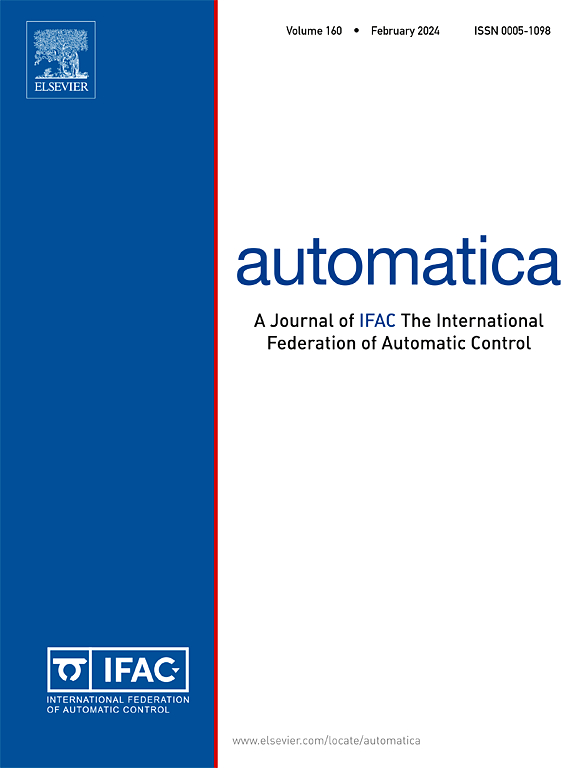PTNDO-based distributed active fault-tolerant control for leader–follower vehicular formation with unknown direction faults
IF 5.9
2区 计算机科学
Q1 AUTOMATION & CONTROL SYSTEMS
引用次数: 0
Abstract
This paper investigates the problem of distributed predefined-time active fault-tolerant control for vehicular formation systems subject to unknown direction actuator faults, unknown nonlinear dynamics, and external disturbances. First, two novel predefined-time stability lemmas are proposed, eliminating the need for quadratic fractional functions or piecewise continuous functions, thereby avoiding singularity issues. Subsequently, a novel predefined-time nonlinear disturbance observer (PTNDO) is designed to accurately estimate the lumped disturbance within a predefined time. It is worth mentioning that, based on the proposed PTNDO, a novel reverse fault detector (RFD) by utilizing the disturbance estimation error is developed to accurately detect the reverse faults, and then a predefined-time active fault-tolerant strategy is constructed to avoid the control input peaks and excessive control gains caused by existing Nussbaum function-based methods. Furthermore, the proposed fault-tolerant control strategy not only ensures that the formation error converges to a neighborhood near the origin within a predefined time but also maintains inter-vehicle communication connectivity and collision avoidance. Finally, simulation experiments demonstrate the effectiveness and superiority of the proposed control strategy.
未知方向故障下leader-follower车辆编队的ptndo分布式主动容错控制
研究了存在未知方向执行器故障、未知非线性动力学和外部干扰的车辆编队系统的分布式预定义时间主动容错控制问题。首先,提出了两个新的预定义时间稳定性引理,消除了二次分数函数或分段连续函数的需要,从而避免了奇异性问题;随后,设计了一种新的预定义时间非线性扰动观测器(PTNDO),在预定义时间内精确估计集总扰动。值得一提的是,在提出的PTNDO的基础上,开发了一种利用干扰估计误差的反向故障检测器(RFD)来准确检测反向故障,然后构建了一种预定义时间主动容错策略,以避免现有基于Nussbaum函数的方法造成的控制输入峰值和过大的控制增益。此外,所提出的容错控制策略不仅保证了编队误差在预定时间内收敛到原点附近的邻域,而且保持了车间通信的连通性和避免碰撞。最后,通过仿真实验验证了所提控制策略的有效性和优越性。
本文章由计算机程序翻译,如有差异,请以英文原文为准。
求助全文
约1分钟内获得全文
求助全文
来源期刊

Automatica
工程技术-工程:电子与电气
CiteScore
10.70
自引率
7.80%
发文量
617
审稿时长
5 months
期刊介绍:
Automatica is a leading archival publication in the field of systems and control. The field encompasses today a broad set of areas and topics, and is thriving not only within itself but also in terms of its impact on other fields, such as communications, computers, biology, energy and economics. Since its inception in 1963, Automatica has kept abreast with the evolution of the field over the years, and has emerged as a leading publication driving the trends in the field.
After being founded in 1963, Automatica became a journal of the International Federation of Automatic Control (IFAC) in 1969. It features a characteristic blend of theoretical and applied papers of archival, lasting value, reporting cutting edge research results by authors across the globe. It features articles in distinct categories, including regular, brief and survey papers, technical communiqués, correspondence items, as well as reviews on published books of interest to the readership. It occasionally publishes special issues on emerging new topics or established mature topics of interest to a broad audience.
Automatica solicits original high-quality contributions in all the categories listed above, and in all areas of systems and control interpreted in a broad sense and evolving constantly. They may be submitted directly to a subject editor or to the Editor-in-Chief if not sure about the subject area. Editorial procedures in place assure careful, fair, and prompt handling of all submitted articles. Accepted papers appear in the journal in the shortest time feasible given production time constraints.
 求助内容:
求助内容: 应助结果提醒方式:
应助结果提醒方式:


